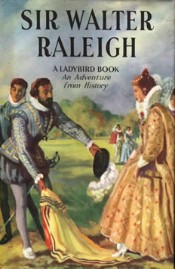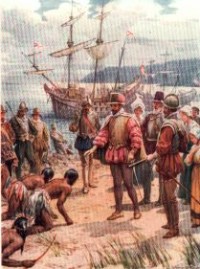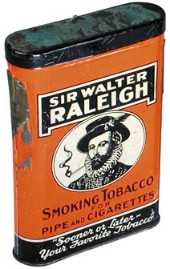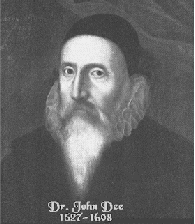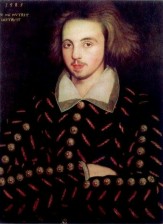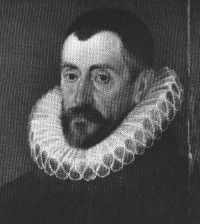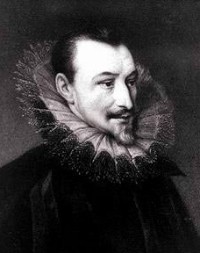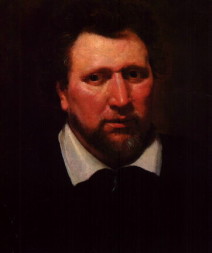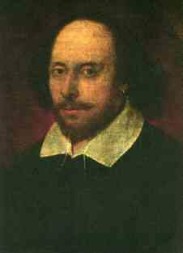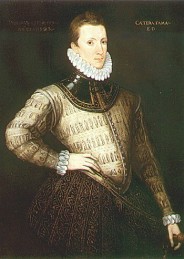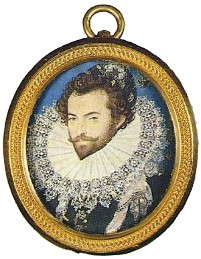|
On
just a few occasions in the history of the
Western World, fate or coincidence have
conspired to bring together, in the same
place and at the same time, a collection
of truly extraordinary individuals - individuals
whose collective impact on the political,
social and cultural development of mankind
has far exceeded the sum of their parts.
One such moment in history arose in Classical
Rome, under Julius Caesar, when the first
Emperor of the Known World rubbed shoulders
with Pompey the Great, Sulla, Cicero, Atticus,
Crassus, Brutus, Clodius, Catullus, and
Marcus Antonius. Likewise, in the Florence
of Lorenzo ("the Magnificent")
de Medici, a population of less than 100,000
included Leonardo da Vinci, Michelangelo,
Donatello, Botticelli and Machiavelli. So
it was that in Elizabethan London, a constellation
of historical stars came together in a city
less than one-tenth - perhaps as little
as one-twentieth - the size of modern-day
Brisbane.
It
seems more than accidental that this phenomenon
has often coincided with the regimes of
visionary autocratic rulers, and Elizabeth
I was no exception. This enigmatic woman's
45-year reign was, in many ways, the mid-point
between the absolute monarchy which preceded
the Great Charter of 1215, and the constitutional
monarchy presaged by the Bill of Rights
of 1689. The last of the Tudor sovereigns
was as autocratic as her father, Henry VIII,
but less vicious; no less cunning than her
cousin and successor, James I, but not so
duplicitous. The Virgin Queen's handling
of policy issues - domestic, foreign and
military - displayed a wisdom and subtlety,
strangely at odds with her petty and sometimes
childish behaviour amongst the members of
her court. She was naively prone to the
flattery of the handsome young men with
whom she surrounded herself, another trait
which she shared with James I. But,unlike
James, Elizabeth was masterful at playing
her retinue off against one another, and
possessed an uncanny ability to promote
her most loyal and talented retainers to
positions which suited their individual
skills.
three popular views
of Sir Walter Raleigh: the chivalrous courtier;
the
explorer and colonist; the man who (supposedly)
introduced tobacco to Europe
Dominant
in her immediate circle was William Cecil,
Lord Burghley, often identified as the inspiration
for the character of Polonius in Shakespeare's
Hamlet - a "tedious old fool"
to the younger and more adventurous members
of the court, but a gifted administrator
who, as Secretary of State and later Lord
Treasurer, was largely responsible for the
financial and domestic security which characterised
the Queen's long reign. Burghley was in
due course succeeded as the Queen's principal
minister by his hunchbacked second son,
Sir Robert Cecil (subsequently 1st Earl
of Salisbury), whose political intrigues
were as crooked as his spine,and may have
contributed to the theatrical device often
employed by Shakespeare, of associating
physical deformities with deformities of
moral character. As a recent writer (Nieves
Mathews, Francis Bacon: The History of
a Character Assassination, 1996, p.236)
has observed: "A craving for political
power could be detected in the calculated
concentration with which Robert Cecil camouflaged
his wide network of corruption over the
years, so successfully that it has only
recently been uncovered."
Another
prominent figure at Elizabeth's court was
a shadowy character, Dr John Dee, who somehow
epitomises the collision of Dark Ages mysticism
and Renaissance learning. Dee would today
be described as the government's scientific
adviser, and he was undoubtedly a man of
great learning, especially in the fields
of mathematics, astronomy, geography and
navigation. But he also served as the Queen's
spiritualist and astrologer, conducting
séances and the like, and is said to have
inspired the character of Prospero in Shakespeare's
The Tempest. As a mariner, Sir Walter
Raleigh was naturally interested to obtain
the benefits of Dee's knowledge regarding
geography and navigation; but Dee's reputation
as a mystic and necromancer opened Raleigh
to the charge of being associated with atheism
and the "black arts".
|
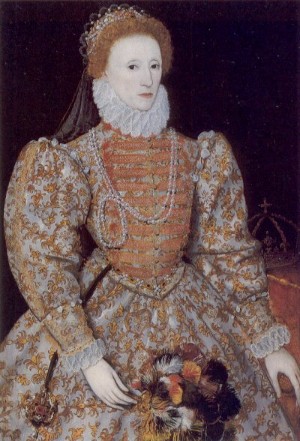
Queen
Elizabeth I
|
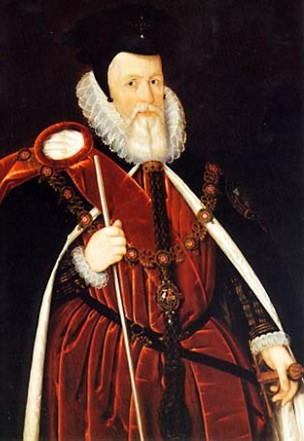
Lord
Burghley
|
Raleigh,
himself, was something of an amateur scientist,
particularly interested in botanical specimens
obtained from the New World, and their potential
use for medicinal purposes; he is also remembered
(albeit inaccurately) as the person who
introduced the smoking of tobacco to Europe
- a dubious title which rightfully belongs
to his kinsman, the notorious privateer
Sir John Hawkins. In an age of religious
zealotry and heretical suspicion, Raleigh's
interest in genuine scientific experimentation
enhanced his reputation as dabbling in sorcery.
In
his heyday, he surrounded himself with some
of the most controversial intellects of
his age, including mathematicians, astronomers,
geographers and students of the natural
sciences, as well as poets, playwrights,
and philosophers. They met at Durham House,
the grand London residence which Queen Elizabeth
expropriated from the Bishop of Durham and
provided for Raleigh's use. This group is
often identified with the "School of
Night" in Shakespeare's Love's Labours
Lost.
the
"School of Night" - Dr John Dee
and Christopher Marlowe
and Queen Elizabeth's
spymaster, Sir Francis Walsingham
Elizabeth's
England enjoyed unprecedented advances in
military strength and strategic influence,
and in cultural development. The former
was achieved largely through the efforts
of privateers - in truth, little more than
licensed pirates - like Hawkins and Sir
Francis Drake, and more high-minded navigators
and explorers like Sir Humphrey Gilbert
and his half-brother, Raleigh. Elizabeth's
reign was also a golden age of literature,
though the brilliancy of the single greatest
writer in the history of the English language,William
Shakespeare, has tended to eclipse the lesser
lights of Christopher Marlowe, Edmund Spenser,
Ben Jonson, and John Lily.
There
is no record that Shakespeare and Raleigh
were personally acquainted, although they
had many mutual acquaintances. Shakespeare's
works contain a number of characters and
references arguably inspired by Raleigh
- including, as we shall see, an unambiguous
reference to Raleigh's trial. The character
of Armado in Love's Labours Lost
is thought to be a caricature of Sir Walter,
made all the more ironic because Raleigh's
fanatical hatred of the Spanish is parodied
by a character described as "a fanatical
Spaniard".
Raleigh's
literary circle: Edmund Spencer; Ben Johnson;
William Shakespeare
Raleigh's
literary connections included Ben Jonson
- sometime tutor to Raleigh's eldest son,
Wat - and the poet Edmund Spencer, to whom
Raleigh was a close friend and patron. A
rather more controversial connection existed
between Raleigh and Shakespeare's major
rival, Kit Marlowe, who was one of the Durham
House "School of Night". Marlowe
was a notorious atheist, and also
openly homosexual - to him is attributed
the aphorism, "All them who love
not tobacco and boys are fools."
When not writing plays, Marlowe was
on the payroll of Sir Francis Walsingham,
England's first semi-official spymaster.
In 1593, Marlowe was arrested and charged
before the Star Chamber with blasphemy and
treason; but was then (astonishingly) released
on bail. Within 10 days, he was dead - stabbed,
supposedly, in an argument over who should
pay the bill in a tavern at Deptford.
The credibility of this "official"
version of Marlowe's death is not enhanced
by the fact that Marlowe actually died at
a private home - owned, coincidentally,
by a cousin of Cecil's - rather than a tavern;
the fact that the man who inflicted the
fatal wound, along with his two companions,
were all members of Walsingham's secret
service; and the fact that the killer
rapidly received a royal pardon, and immediately returned
to Walsingham's service. The true circumstances
surrounding Marlowe's death have been
debated ever since, with conspiracy
theories ranging from the possibility that
Marlowe was a double-agent who had
to be eliminated to protect state secrets;
that his death was necessary to prevent
his implicating others when he came to trial
before the Star Chamber; that he was the
victim of a power play between the competing
Cecil, Walsingham, Essex and Raleigh factions
at court; that his death was "staged",
and that he in fact survived with a new
identity provided by his secret service
employers, possibly to avoid his impending
Star Chamber trial (and then went on,
as it has been suggested, to "ghost
write" Hamlet and other plays
usually attributed to Shakespeare); or that
his homosexual liaison with a prominent
courtier was a potential source of
embarrassment. Raleigh has from time
to time been implicated in each of these
conspiracy theories, except the last - not
even the most fanciful of them has
ever challenged Raleigh's sexual orientation.
The
writing of poetry (though not plays)
was regarded as a significant gentlemanly
attainment amongst the inner circle
at Elizabeth's court, and the noted
poets of the age included three of
Her Majesty's gentleman-soldiers, Sir Philip
Sidney, Edward De Vere (17th Earl
of Oxford) and Raleigh. The predominance
of aristocratic literati at
Elizabeth's court has led to the suggestion
- mainly emanating from the "lunatic
fringe" of serious literary study
- that William Shakespeare was in fact the
nom de guerre of a high-born author
who preferred to conceal his true identity,
or perhaps the barely literate "front
man" for the supposed "real"
author: maybe the Earl of Oxford, maybe
Sir Francis Bacon, maybe Christopher Marlowe,
maybe the Earl of Derby, maybe Raleigh (with
or without collaboration from Bacon), or
maybe even the Queen herself.
Gentleman-poets
of Elizabeth's Court: Sir Philip
Sidney, the Earl
of Oxford, and Raleigh
Elizabeth's
reign also produced a number of outstanding
jurists. But in the legal world, as
in the literary world, the fame of
one has tended to out-shine the many;
and that one was Sir Edward Coke. Amongst
his contemporary lawyers, Ellesmere
and Bacon are perhaps better remembered for
their feuds with Coke, and in Bacon's case,
for his philosophical and other non-judicial
writings.
|
